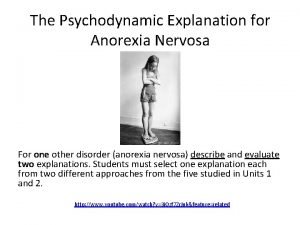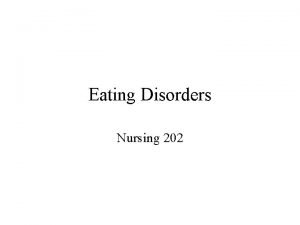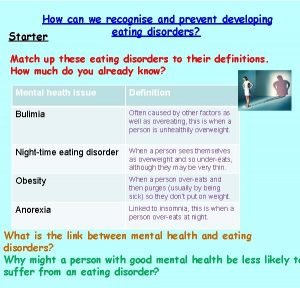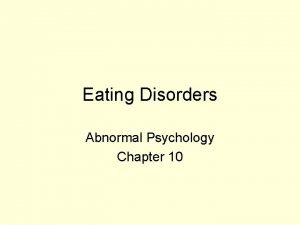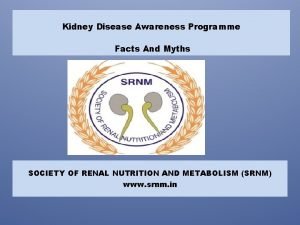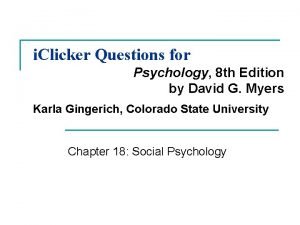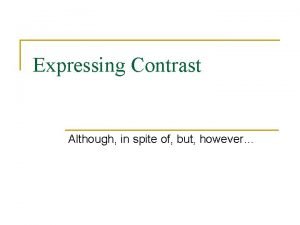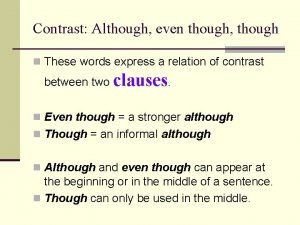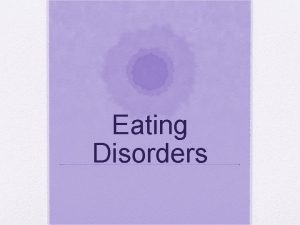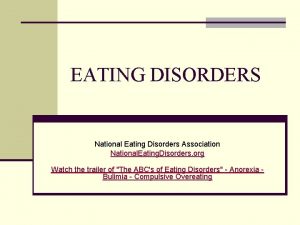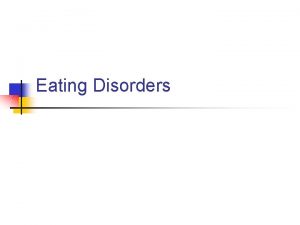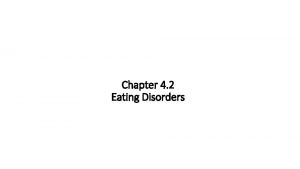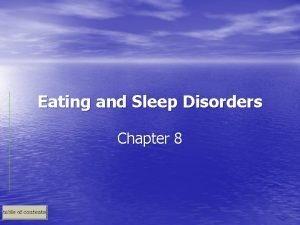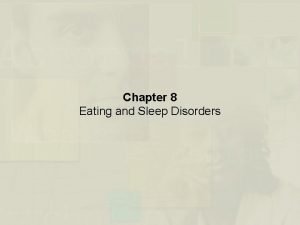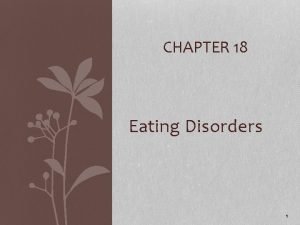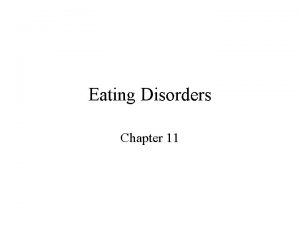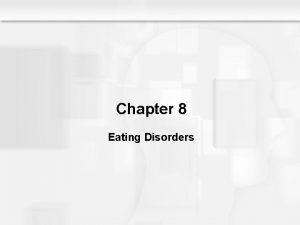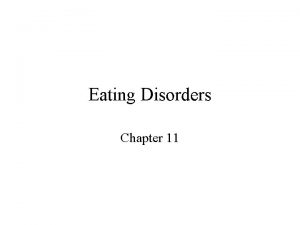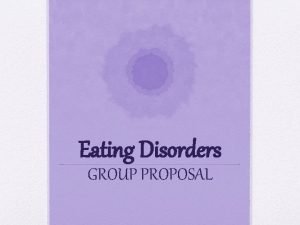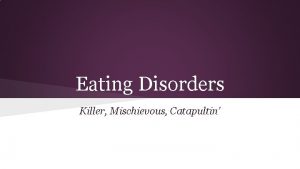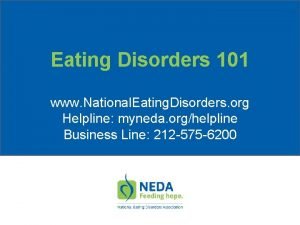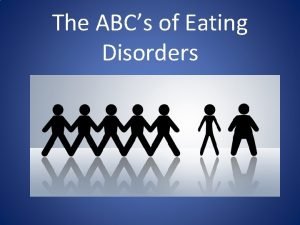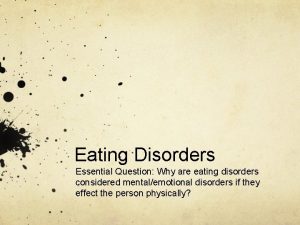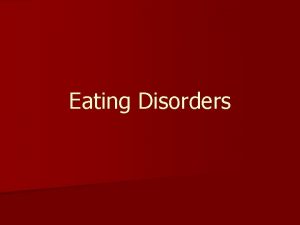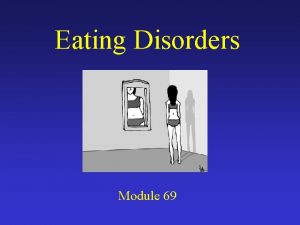Chapter 11 Eating Disorders Eating Disorders Although not































- Slides: 31

Chapter 11 Eating Disorders

Eating Disorders ¨ Although not historically true, current Western beauty standards equate thinness with health and beauty ¨ There has been a rise in eating disorders in the past three decades • The core issue is a morbid fear of weight gain ¨ Two main diagnoses: • Anorexia nervosa • Bulimia nervosa Slide 2

Anorexia Nervosa ¨ The main symptoms of anorexia nervosa are: • A refusal to maintain more than 85% of normal body weight • Intense fears of becoming overweight • A distorted view of body weight and shape • Amenorrhea Slide 3

Anorexia Nervosa ¨ There are two main subtypes: • Restricting type • Lose weight by restricting “bad” foods, eventually restricting nearly all food • Show almost no variability in diet • Binge-eating/purging type • Lose weight by vomiting after meals, abusing laxatives or diuretics, or engaging in excessive exercise • Like those with bulimia nervosa, people with this subtype may engage in eating binges Slide 4

Anorexia Nervosa ¨ About 90– 95% of cases occur in females ¨ The peak age of onset is between 14 and 18 years ¨ Around 0. 5% of females in Western countries develop the disorder • Many more display some symptoms ¨ Rates of anorexia nervosa are increasing in North America, Japan, and Europe Slide 5

Anorexia Nervosa ¨ The “typical” case: • A normal to slightly overweight female has been on a diet • Escalation to anorexia nervosa may follow a stressful event • Separation of parents • Move or life transition • Experience of personal failure • Most patients recover • However, about 2 to 6% become seriously ill and die as a result of medical complications or suicide Slide 6

Anorexia Nervosa: The Clinical Picture ¨ The key goal for people with anorexia nervosa is thinness • The driving motivation is FEAR: • Of becoming obese • Of losing control of body shape and weight Slide 7

Anorexia Nervosa: The Clinical Picture ¨ Despite their dietary restrictions, people with anorexia are extremely preoccupied with food • This includes thinking and reading about food and planning for meals • This relationship is not necessarily causal • It may be the result of food deprivation, as evidenced by the famous 1940 s “starvation study” with conscientious objectors Slide 8

Anorexia Nervosa: The Clinical Picture ¨ People with anorexia nervosa also demonstrate distorted thinking: • Often have a low opinion of their body shape • Tend to overestimate their actual proportions • Adjustable lens assessment technique – overestimate size by 20% • Hold maladaptive attitudes and beliefs • “I must be perfect in every way” • “I will be a better person if I deprive myself” • “I can avoid guilt by not eating” Slide 9

Anorexia Nervosa: The Clinical Picture ¨ People with anorexia may also display certain psychological problems: • Depression (usually mild) • Anxiety • Low self-esteem • Insomnia or other sleep disturbances • Substance abuse • Obsessive-compulsive patterns • Perfectionism Slide 10

Anorexia Nervosa: Medical Problems ¨ Caused by starvation: • Amenorrhea • Slow heart rate • Low body temperature • Metabolic and electrolyte imbalance • Low blood pressure • Body swelling • Reduced bone density • Dry skin, brittle nails • Poor circulation • Lanugo Slide 11

Bulimia Nervosa ¨ Bulimia nervosa, also known as “binge-purge syndrome, ” is characterized by binges: • Bouts of uncontrolled overeating during a limited period of time • Often objectively more than most people would/could eat in a similar period Slide 12

Bulimia Nervosa ¨ The disorder is also characterized by compensatory behaviors, which mark the subtype of the condition: • Purging-type bulimia nervosa • Vomiting • Misusing laxatives, diuretics, or enemas • Nonpurging-type bulimia nervosa • Fasting • Exercising excessively Slide 13

Bulimia Nervosa ¨ Like anorexia nervosa, about 90– 95% of bulimia nervosa cases occur in females ¨ The peak age of onset is between 15 and 21 years ¨ Symptoms may last for several years with periodic letup Slide 14

Bulimia Nervosa ¨ Patients are generally of normal weight • May be slightly overweight • Often experience weight fluctuations ¨ “Binge-eating disorder” may be a related diagnosis • Symptoms include a pattern of binge eating with NO compensatory behaviors (such as vomiting) • This condition is not yet listed in the DSM Slide 15

Bulimia Nervosa ¨ Teens and young adults have frequently attempted binge-purge patterns as a means of weight loss, often after hearing accounts of bulimia from friends or the media ¨ In one study: • 50% of college students reported periodic binges • 6% tried vomiting • 8% experimented with laxatives at least once Slide 16

Bulimia Nervosa: Binges ¨ For people with bulimia nervosa, the number of binges per week can range from 2 to 40 • Average: 10 per week ¨ Binges are often carried out in secret • Binges involve eating massive amounts of food rapidly with little chewing • Usually sweet foods with soft texture • Binge-eaters commonly consume more than 1500 calories (often more than 3000 calories) per binge episode Slide 17

Bulimia Nervosa: Binges ¨ Binges are usually preceded by feelings of tension and/or powerlessness ¨ Although the binge itself may be pleasurable, it is usually followed by feelings of extreme self-blame, guilt, depression, and fears of weight gain and “discovery” Slide 18

Bulimia Nervosa: Compensatory Behaviors ¨ After a binge, people with bulimia nervosa try to compensate for and “undo” the caloric effects ¨ The most common compensatory behaviors: • Vomiting • Affects ability to feel satiated greater hunger and bingeing • Laxatives and diuretics • Almost completely fail to reduce the number of calories consumed Slide 19

Bulimia Nervosa ¨ The “typical” case: • A normal to slightly overweight female has been on an intense diet • Research suggests that even among normal subjects, bingeing often occurs after strict dieting • For example, a study of binge-eating behavior in a low -calorie weight loss program found that 62% of patients reported binge-eating episodes during treatment Slide 20

Bulimia Nervosa vs. Anorexia Nervosa ¨ Similarities: • Onset after a period of dieting • Fear of becoming obese • Drive to become thin • Preoccupation with food, weight, appearance • Elevated risk of self-harm or attempts at suicide • Feelings of anxiety, depression, perfectionism • Substance abuse • Disturbed attitudes toward eating Slide 21

Bulimia Nervosa vs. Anorexia Nervosa ¨ Differences: • People with bulimia are more worried about pleasing others, being attractive to others, and having intimate relationships • People with bulimia tend to be more sexually experienced • People with bulimia display fewer of the obsessive qualities that drive restricting-type anorexia • People with bulimia are more likely to have histories of mood swings, low frustration tolerance, and poor coping Slide 22

Bulimia Nervosa vs. Anorexia Nervosa ¨ Differences: • People with bulimia tend to be controlled by emotion – may change friendships easily • People with bulimia are more likely to display characteristics of a personality disorder • Different medical complications: • Only half of women with bulimia experience amenorrhea vs. almost all women with anorexia • People with bulimia suffer damage caused by purging, especially from vomiting and laxatives Slide 23

What Causes Eating Disorders? ¨ Most theorists subscribe to a multidimensional risk perspective: • Several key factors place individuals at risk • More factors = greater risk • Leading factors: • Sociocultural conditions (societal and family pressures) • Psychological problems (ego, cognitive, and mood disturbances) • Biological factors Slide 24

What Causes Eating Disorders? Societal Pressures ¨ Many theorists argue that current Western standards of female attractiveness have contributed to the rise of eating disorders • Standards have changed throughout history toward a thinner ideal • Miss America contestants have declined in weight by 0. 28 lbs/yr; winners have declined by 0. 37 lbs/yr • Playboy centerfolds have lower average weight, bust, and hip measurements than in the past Slide 25

What Causes Eating Disorders? Societal Pressures ¨ Certain groups are at greater risk from these pressures: • Models, actors, dancers, and certain athletes • Of college athletes surveyed, 9% met full criteria for an eating disorder while another 50% had symptoms • 20% of surveyed gymnasts met full criteria for an eating disorder Slide 26

What Causes Eating Disorders? Ego Deficiencies and Cognitive Disturbances ¨ Bruch argues that eating disorders are the result of disturbed mother–child interactions which lead to serious ego deficiencies in the child and to severe cognitive disturbances Slide 27

Treatments for Eating Disorders ¨ Eating disorder treatments have two main goals: • Correct abnormal eating patterns • Address broader psychological and situational factors that have led to and are maintaining the eating problem • This often requires the participation of family and friends Slide 28

Treatments for Anorexia Nervosa ¨ The initial aims of treatment for anorexia nervosa are to: • Restore proper weight • Recover from malnourishment • Restore proper eating Slide 29

Treatments for Bulimia Nervosa ¨ Treatment programs are relatively new but have risen in popularity ¨ Treatment is frequently offered in specialized eating disorder clinics Slide 30

Treatments for Bulimia Nervosa ¨ The initial aims of treatment for bulimia nervosa are to: • Eliminate binge-purge patterns • Establish good eating habits • Eliminate the underlying cause of bulimic patterns ¨ Programs emphasize education as much as therapy Slide 31
 Chapter 18 eating and feeding disorders
Chapter 18 eating and feeding disorders Chapter 11 lesson 1 maintaining a healthy weight
Chapter 11 lesson 1 maintaining a healthy weight Although they knew god they did not glorify him
Although they knew god they did not glorify him York eating disorder unit
York eating disorder unit Eating disorders in uae
Eating disorders in uae Sarah fogarty
Sarah fogarty Chimpanzee eating termites
Chimpanzee eating termites Isabelle caro
Isabelle caro Anorexia psychodynamic explanation
Anorexia psychodynamic explanation Mnt for eating disorders
Mnt for eating disorders Hypothalamus and eating disorders
Hypothalamus and eating disorders How to spot eating disorders
How to spot eating disorders Kate moss eating disorder
Kate moss eating disorder Sudden and violent but brief; fitful; intermittent
Sudden and violent but brief; fitful; intermittent I can not stop eating
I can not stop eating Thesis statement although
Thesis statement although Subordinate conjunction examples
Subordinate conjunction examples The moon is faithful although blind
The moon is faithful although blind Linking words fce
Linking words fce Despite although
Despite although The excitement that lingers after a frightening event
The excitement that lingers after a frightening event Although even though despite in spite of exercises
Although even though despite in spite of exercises Even though i walk through the valley
Even though i walk through the valley Even though contrast
Even though contrast My hogs by kayla afinson
My hogs by kayla afinson Although thesis statement
Although thesis statement But however although
But however although Does a simple sentence have a dependent clause
Does a simple sentence have a dependent clause What is thamo in grammar
What is thamo in grammar Although it was raining maria went for a jog at the park
Although it was raining maria went for a jog at the park Thesis statement fill in the blank
Thesis statement fill in the blank Juan continued playing although he injured his knee
Juan continued playing although he injured his knee








